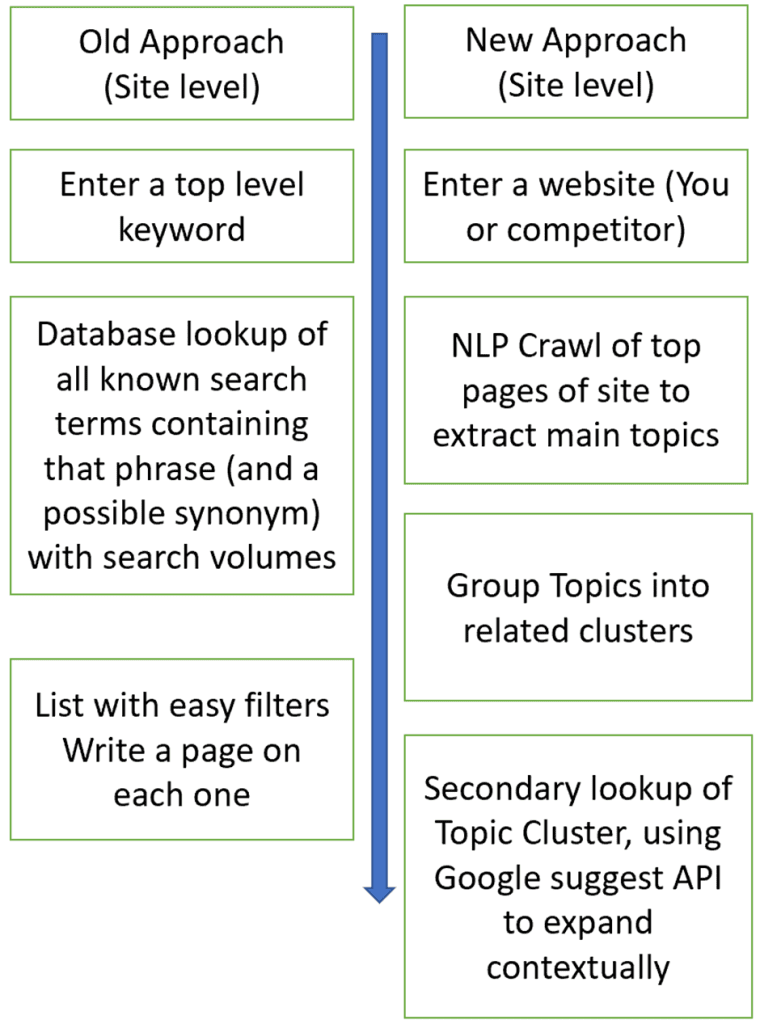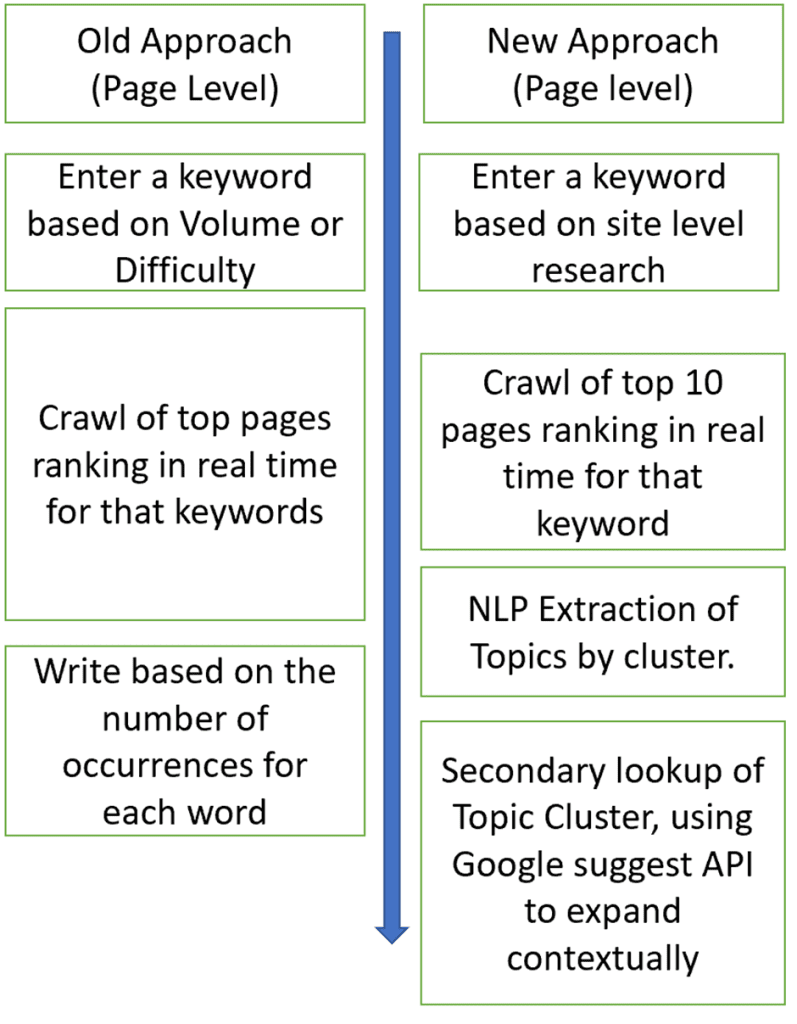Current keyword research for SEO is based around finding a list of keywords with comparative search volumes and some element of competition. (That is to say, how hard it would be to rank for the keyword). Typically, the equation to evaluate the best keywords in a list has been like this:
Keyword Opportunity = (Search volume X Cost Per Click) / Level of difficulty
It’s a shocking fact that most keyword research is wrong!
This approach has become increasingly flawed. Writing a whole article for every keyword that people search for shows scant regard for in-depth content and scant regard for the reader’s intelligence! But without topic clustering and semantic connections, when it comes to an entity-based approach to SEO, the strategy is also flawed for several reasons:
- Synonyms are essential to connect keywords
- Without Synonyms, Keyword Research results in Cannibalisation
- Cannibalization creates Overheads
- Clustering increases Context
- Keyword research needs to better understand user intent
- There is a much better approach to Keyword Research described below
These are groundbreaking concepts to many SEOs. So do not stop reading at these headlines. Let’s really understand these observations:

Synonyms are Important
What is the material difference between (for example) a page about “Home insurance” and a page about “House insurance”? Even though both of these terms show tremendous potential, according to Semrush’s keyword tools:
| Search term (keyword) | Vol (UK) | Vol (USA) |
| House Insurance | 40.5K | 27.1K |
| Home Insurance | 90.5K | 135.0K |
Looking at these headline numbers, I imagine most insurance companies writing a page targeted for each term, even though they mean the same thing. But look at the organic results (screenshot) when I type in “house insurance” (from the UK). The top results all use the more popular term “home insurance”, rendering a separate page about “house insurance” obsolete.

Most keyword analysis tools have, at best, a rudimentary understanding of synonyms. They might group plurals, for example, but not much else.
Multiple pages cause Cannibalization.
If you write many pages focusing on slight variations of the same idea, you risk Cannibalization. All of the pages will use very similar keywords within each article. Cannibalization is when a search engine cannot understand where the authority around a topic or keyword lies within your website. By seeing the same ideas and repetitive keywords on ten different pages, Google might dilute its opinion of how authoritative each article is for a given topic by 10. Whilst a gross simplification of Google’s objectives, Google benefits from clarity about what pages are most important for each TOPIC, not each keyword. Remember, Google ranks pages, not domains.
One way to minimize Cannibalization is to consistently link topics to a cornerstone page about said topic. If you mention home insurance on the “Claims” page, you should link the mention to the page about home insurance. InLinks automates this process, but consistent linking is not easy when you have multiple pages targeting multiple keywords that mean the same thing.
Multiple Pages create significant Overheads.
Hosting is more expensive, crawling is more costly, and to what end? If you write about the same thing 10 (or 100 times) on ten different URLs, you have spent ten times as much time writing the content in the first place. Then it would help if you interlinked them all, causing headaches for the technical SEO team. There has to be a better way.
Writing around a single keyword loses context and connectivity.
Insightful articles connect several ideas, for the reader, into a coherent story or argument. Often, the ideas NEED to be strung together skilfully by the writer to add real value. Keyword research should not only be done at the site level but also the page level. Many tools will cleverly use the keywords in the copy of the pages already ranking for a given keyword to suggest keywords that you might use in your document for a given keyword. The approach is pretty powerful, but again does not combine synonyms like “house” and “home” and also does not connect words into topics. So using this approach will undoubtedly mean that a keyword audit around “House insurance” is likely to suggest you use the words “insurance” and “home” but is unlikely to demonstrate that the underlying topic is “Home Insurance”, not houses and general insurance.
Keyword Research needs to consider Intent more than volume
Keyword volume does not help content writers satisfy Google users’ needs on its own. Google talks about user intent in its Quality Rater guidelines quite a bit. Google wants the results they show to answer the underlying query that the user posed. This is rarely a single keyword, but verbs surround it like “How” or “why”.
Google’s Auto Suggest feature is uncannily good at predicting the user’s search query these days. Google’s Auto Suggest gives us a way into the inner mind of Google and also an approach for a better way to carry out keyword research, both at a site and a page level.
A Better Approach to Keyword Research
Two Approaches to Keyword Research (Site Level)

A new approach to planning site content
We propose that instead of using Keyword search volumes to inform your site’s content, a better approach is to build content based on Google Suggest data. This represents REAL search volume, confirmed by being in the Google Suggest database in the first place. The challenge, of course, is to know WHICH Google suggests are appropriate for your content and how can you extract these at a reasonable velocity.

The way this is achieved is by starting the Google Suggest lookup with the correct underlying topics.
In the example above, the concepts are pretty diverse around the word “bride”, but they are absolute GOLD around the idea of “Bridesmaid Gifts”.

Now, THIS is the basis for building out sections on a Bridesmaid Gift site! (or the Bridesmaid gift section of a larger site around weddings).
The way we get to THESE phrases is through a robust NLP algorithm which can extract the underlying topics, by the entity and vertical, from existing text.
Two Approaches to Keyword Research (Page Level)
The approach is similar at a page level in deciding what keywords (or topics) to include on a page for any subject.

Why is this new approach to Keyword Research better?
This new approach to Keyword Research is better because:
- It connects keywords to use on pages to keywords to use for organizing whole sites into sections.
- Google suggest delivers keywords and questions based on the content and based on user behaviour
- Google Suggest results have geo-localization at the city level
- Volumes can be grouped into cluster levels and also be context based.
We believe this to be a far superior approach, which plays to the “Entity SEO” hymn sheet.
- Why most Keyword Research is done wrong (KW Volume, not connected ideas)
- Our take on Keyword Research
- The underlying approach (Google Suggest + NLP + Clustering)

Our Keyword Research Tool
Based on this logic, Inlinks has upgraded its Content Optimization module to create a new state-of-the-art Keyword Research Tool which is based on this Topic Research approach.





Namaste,
Thanks for this good information.
Topic Clustering in Keyword Research have new dimensions.
Good job, best wishes…..
Big thanks
Leave a Reply
Want to join the discussion?Feel free to contribute!